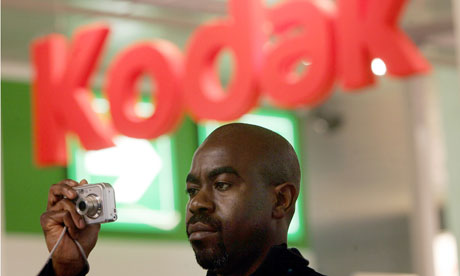
Kodak, the company that pioneered home photography, is to give up making cameras after more than 110 years.
The company, whose little yellow film boxes could once be found throughout the world, said on Thursday it plans to "phase out its dedicated capture devices business", which includes all digital cameras, video cameras and digital photo frames.
It comes less than a month after Kodak Eastman filed for bankruptcy protection in the US as it finally succumbed to a digital revolution that left its products obsolete following intense competition from rivals in the Far East.
"For some time, Kodak's strategy has been to improve margins in the capture device business by narrowing our participation in terms of product portfolio, geographies and retail outlets," Kodak's chief marketing officer Pradeep Jotwani said. "Today's announcement is the logical extension of that process, given our analysis of industry trends."
Kodak said it hopes pulling out of cameras will save the company, which has $6.8bn (£4.2bn) of debts, more than $100m a year. It will stop all production of capture devices within the first half of 2012.
Exiting the business is expected to cost Kodak $30m. The company has already closed 13 factories and cut 47,000 jobs. It ceased manufacturing its famous Kodachrome film in 2009.
The definitive end of the "Kodak moment" comes more than 130 years after a "not especially gifted" high school dropout, George Eastman, founded the company that dominated photography for most of the 20th century.
Kodak produced the first mass market Brownie camera in 1900, priced at $1, with the slogan "You push the button, we do the rest". The company went on to control more than 90% of the US film market, and its Kodachrome film was so beloved of amateur and professional photographers that Paul Simon wrote a hit song about it.
In 1975 it created the first digital camera, which was the size of a toaster, had to be held still for a 23-second exposure and only produced a 0.01 megapixel black and white image.
But the company decided not to bring its new invention to market because of fears it would cannibalise its – at the time very profitable – business selling chemicals for traditional film developing. When it finally got round to making mass-market digital cameras it had been left behind by much cheaper rivals in Japan.
Kodak will now concentrate on its network of more than 100,000 photo booths worldwide, its inkjet printer business and its Facebook app that allows users to turn digital albums into real prints.
The company, which has been given 18 months' breathing space by a $950m loan from Citigroup, is also trying to sell 1,100 patents that it believes are worth more than $1bn.

